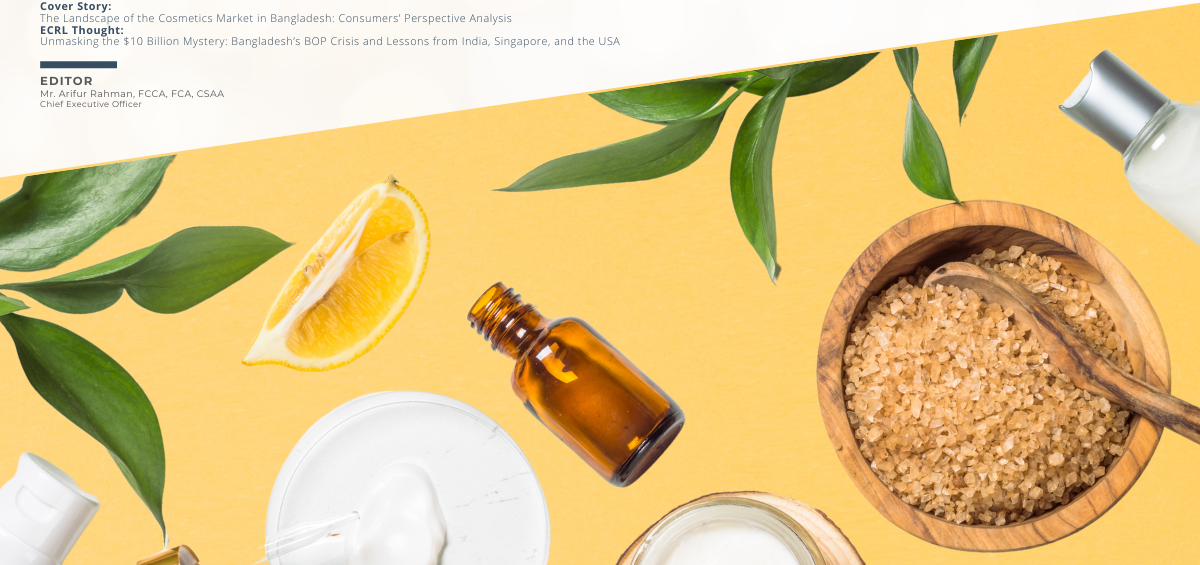The cosmetic industry in Bangladesh is witnessing significant growth, driven by rising consumer awareness and changing lifestyles influenced by social media and celebrity culture. In 2023, the market for toiletries and cosmetic products was valued at approximately BDT 25,000 crore, with an annual growth rate of 3.48% projected from 2024 to 2028. This growth is fueled by increased consumer purchasing power, economic factors such as currency fluctuations and inflation, and the expansion of the e-commerce sector. Cosmetic products, defined as items used to clean, improve, or change the complexion, skin, hair, nails, or teeth, hold both symbolic and straightforward value, enhancing physical appearance and personal hygiene while also nurturing overall well-being.
 Local companies dominate the Bangladeshi cosmetics market, holding approximately 60% of the market share. Key players include Unilever, Keya Cosmetics, Lily Cosmetics, Aromatic Cosmetics, Square Toiletries, and Kohinoor Chemical Company. These companies have a significant presence in the market, driven by increasing demand for personal grooming and beauty products among the younger generation. The industry’s expansion has also led to substantial employment opportunities across various segments such as manufacturing, retail, and distribution. The cosmetics industry in Bangladesh exhibits significant vertical integration, with companies like Unilever Bangladesh, Square Toiletries Limited, and Marico Bangladesh leading in terms of scale, efficiency, and market reach. These companies benefit from extensive resources and advanced infrastructure, leveraging their global supply chains and international expertise.
Local companies dominate the Bangladeshi cosmetics market, holding approximately 60% of the market share. Key players include Unilever, Keya Cosmetics, Lily Cosmetics, Aromatic Cosmetics, Square Toiletries, and Kohinoor Chemical Company. These companies have a significant presence in the market, driven by increasing demand for personal grooming and beauty products among the younger generation. The industry’s expansion has also led to substantial employment opportunities across various segments such as manufacturing, retail, and distribution. The cosmetics industry in Bangladesh exhibits significant vertical integration, with companies like Unilever Bangladesh, Square Toiletries Limited, and Marico Bangladesh leading in terms of scale, efficiency, and market reach. These companies benefit from extensive resources and advanced infrastructure, leveraging their global supply chains and international expertise.
The study employed a non-probability sampling approach known as convenience sampling, collecting primary data from 41 respondents within the Dhaka metropolitan area through a structured questionnaire. Additionally, qualitative data was gathered through interviews with four leading super shops, five retailers of different international cosmetic brands located in Khulna, Dhaka, Rajshahi, Chittagong, Sylhet, and Barishal, one key importer of LAFZ cosmetics, and one key industry insider from Kohinoor Chemical Ltd. The primary buyers of cosmetics are young to middle-aged individuals, with 73% of respondents aged 25-34 and 17% aged 35-44. Both males and females are consumers of cosmetics, with men increasingly developing their grooming patterns and awareness towards health and self-care. In Bangladesh’s socioeconomic context, male members are still looking after their family needs. According to our study, 51% respondents who purchase cosmetics are also a buyer of cosmetic for their wives or other family members. Marketers use the Premiumization marketing strategy to attract a group of customers with healthy financial and educational status. Our findings postulate that 65.9% cosmetic user have at least a post-graduation degree and 90% of users are part or full-time employed. Demand for local products varies by location, with urban dwellers preferring international brands and rural consumers favoring local products due to availability and affordability. Even urban consumers are segregated based on location like Gulshan, Banani, and Baridhara compare to locations like Bosila, Bou Bazar, and West Jigatola. Consumers in Gulshan and likely areas prefer international products whereas consumers in Bosila and its likely place prefer local production. As Cosmetics are not necessary products, purchasing patterns will vary based on income, and beautification awareness which comes from education and surroundings and we mentioned that earlier according to our findings.
From our study its evident that only 7% people purchase cosmetic daily and 10% purchase weakly basis whereas 56% purchase cosmetics once in a month.
Market insiders suggest several strategies to enhance the appeal of local brands and compete effectively in the evolving cosmetics landscape. Local brands should focus on improving the quality and consistency of their products to match international standards, increasing the range of products offered to cater to diverse consumer preferences, and addressing concerns over counterfeit products by ensuring authenticity and transparency in the supply chain. Emphasizing the use of natural and skin-friendly ingredients can attract health-conscious consumers while leveraging social media and influencer marketing can build brand awareness and loyalty. By implementing these recommendations, local brands can better position themselves in the competitive cosmetics market and meet the evolving needs of Bangladeshi consumers.

